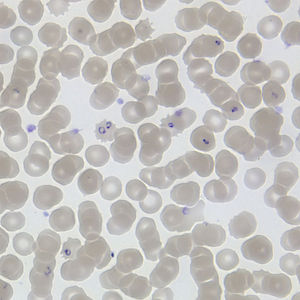White blood cells play a vital role in your immune system. They are also known as leukocytes or sometimes WBCs by doctors. White blood cells circulate in your blood stream, attacking invading bacteria, parasites and any other cells and objects that are not meant to be floating around inside your blood. White blood cells are not all the same. In fact, there are six different types of white blood cells, each of which has a slightly different role to play in your immune defense. The six types of WBCs are split in to two major categories, granulocytes and agranulocytes.
All leukocytes begin life in the bone marrow, although some mature and differentiate in to the various sub-types in other tissues such as the spleen, lymph nodes, or a small organ known as the thymus. Most white blood cells are short lived, typically lasting for only days or weeks before they must be replaced. The three types of granulocytes are: neutrophils, basophils and eosinophils. They are named granulocytes because they contain small vessels of enzymes in membrane-bound “packets”. The enzymes contained in these packets are used by the cells to digest bacteria and other foreign materials. Under a microscope, the packets resemble grains of sand, hence the name granulocyte.
NEUTROPHILS
Neutrophils are the most common type of white blood cell. They account for about 65% of all white blood cells, and are also known as polymorphonuclear leukocytes or a PMN for short. They are the primary defenders against bacterial and fungal infections. Neutrophils can be thought of as the “first responders” in an invasion of foreign bacteria or fungi. Infections are often diagnosed by looking at a total PMN count as it is commonly the first of the white blood cells to become more abundant in an infection. They are the major component in pus and are seen in any process that involves inflammation.
BASOPHILS
Basophils are the least common type of white blood cell. They make up only about 1% of your white blood cells. The primary function of a basophil is to release a chemical known as histamine in response an infection. Histamine is a chemical that has many functions, but it is primarily responsible for initiating an inflammatory reaction.
EOSINOPHILSThe last type of granulocyte is called an eosinophil. They account for about 4% of your leukocytes. These white blood cells are used for two purposes. They are the primary defense against parasitic infections. They are also commonly elevated in cases of allergic reactions, such as hives, or even asthma related to allergies.
LYMPHOCYTES
The first of the agranulocytes are lymphocytes. Like all agranulocytes they lack the membrane-bound granules found in the other category of white blood cells. Lyphocytes account for 25% of white blood cells. There are actually three different types of lymphocytes; B cells, T cells, and Natural Killer Cells. All three types have slightly different functions.
B cells are responsible for making antibodies to foreign materials such as bacteria and viruses. Antibodies are little chemicals that are custom designed to attack specific chemical markers on the outside of the target. When an antibody attaches to an invading cell, it triggers a sequence of reactions that enable your body to kill the invader.
T cells come in two different types, CD4 and CD8. CD4 cells can be thought of as coordinators and facilitators of an immune defense against a virus or bacteria. CD4 T cells are the troops that go in and actually make the kill. Of course, this is a gross oversimplification. The details of T cell functioning is quite complicated and well beyond the scope of this article. Interestingly, it is the CD4 T cells that are the primary immune cell damaged in HIV/AIDS, allowing infections to successfully attack the infected person.
MONOCYTES
Monocytes make up about 6% of white blood cells and have a somewhat unique and interesting role to play in your immune system. Monocytes are rather long lived compared to other white blood cells. They travel around in your blood, looking for bacteria, viruses and other “waste” that needs removal. When they find something that needs cleaning up, they swallow the offending particle in a process known as “phagocytosis”. After swallowing these bits, the monocyte will break the invader in to smaller pieces and present them on its cell surface so that passing T cells can “learn” more about the chemical make-up of the invader and make it easier to kill more of them.
MACROPHAGES
The last type of white blood cell is actually a modified monocyte. Some monocytes travel in to the tissues of your body, outside the bloodstream. When they do this, they transform slightly and become macrophages. The function of a macrophage is similar to that of a monocyte.


